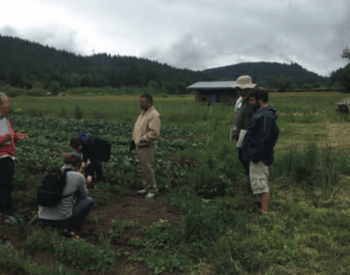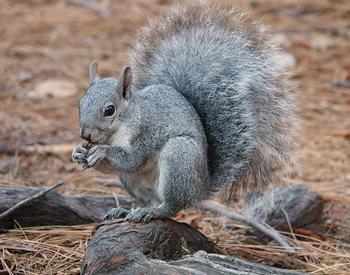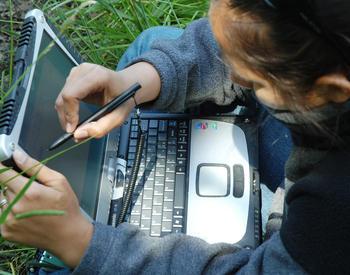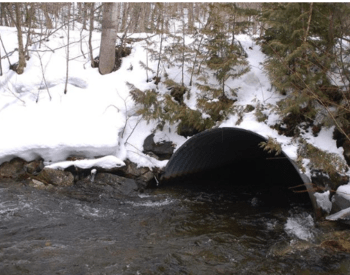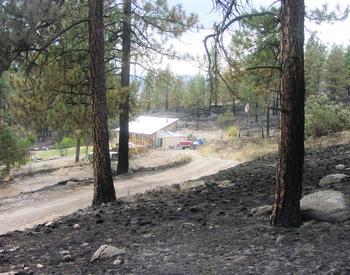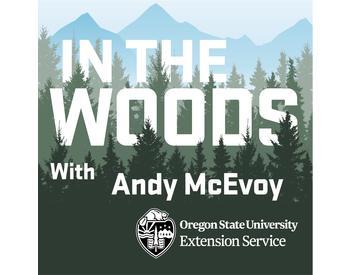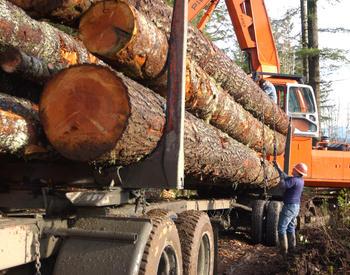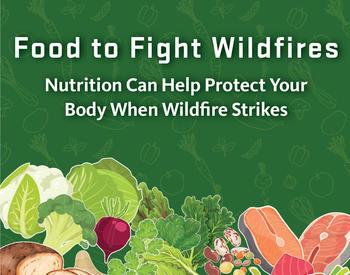Transcript
From the Oregon State University's Extension Service, you are listening to In the Woods with the Forestry and Natural Resources Program. This podcast brings the forest to listeners by sharing the stories and voices of forest scientists, land managers, and enthusiastic members of the public. Each episode, we will bring you research and science based information that aims to offer some insight into what we know and are still learning about forest science and management. Stick around to discover a new topic related to forests on each episode.
Thank you for joining us on another episode of In the Woods. I'm Lauren Grand, Oregon State University Extension Forester and Associate Professor of Practice, and I'll be your host for today's episode. Today's episode is all about indigenous knowledge.
In this episode, we hope to honor and share the wisdom of tribal ecological knowledge in order to help widen the perspective on forest appreciation and stewardship. And we want to know how this knowledge is important in today's world. Joining us on the podcast today is Dr. Cristina Eisenberg.
Dr. Eisenberg is the Oregon State University College of Forestry's Associate Dean for Inclusive Excellence. Maybelle Clark Macdonald, Director of Tribal Initiatives and Natural Resources. Welcome to the podcast, Dr. Eisenberg. It's a pleasure to be here, Lauren. Before we dive into your presentation, Cristina, can you tell us a little bit more about yourself and how you developed your passion around natural resources and collaborative partnerships?
Yes, um, I'm a first generation student. I'm Native American, um, of Raramuri and Western Apache mixed heritage, and, um, as a little girl when I was three years old, uh, my dad took me in the woods and, into the woods, um, to get out of going to church. He made the excuse to my mom that I need to take Cristina for a walk in the woods.
And he took me into an old growth cedar forest in Stanley Park in Vancouver, BC. And it was, it changed my life. That deep immersion in the woods, and I was three years old, and I vividly remember that whole walk, and I was curious about everything in that forest, the understory, the big cedars. And, um, and I, from that point on, I knew that I wanted whatever I ended up doing with the rest of my life, that I wanted to be in the woods.
What a great story. Isn't it so great when you find your connection so young in life and are able to find a career that you really enjoy based on that love that you found? As such a young person. Well, now that we've learned a little bit more about you, um, we're doing this podcast a little bit differently than typical.
We'll be having Cristina do a presentation on Indigenous knowledge. It is coupled with visuals that will be available on our website. Via a YouTube link. So if you are interested in seeing her presentation as well as hearing it, please visit our website @inthewoodspodcast.com so you can follow along with her slides as well.
Take it away, Cristina. Um, my name is, uh, my native name is Mountain Star Woman and I'm Dr. Christina Eisenberg. And I'm going to share with you some thoughts about Indigenous knowledge today. I'll start with the land acknowledgment. Um, land acknowledgments are highly, uh, controversial, and it started out with land acknowledgements becoming very popular for institutions, as the politically correct thing to do.
And, um, starting about five years ago, they became pretty widespread. And the traditional, the standard land acknowledgement, basically, native people see it as an insult. It says, this used to be your land, and we stole it. And it doesn't say anything else about it.
You know, what, what does that mean, ethically or morally? So when I was hired at Oregon State University as the Associate Dean of Inclusive Excellence and Director of Tribal Initiatives in the College of Forestry, part of my position, description, is to decolonize the College of Forestry. To take us beyond the land acknowledgement.
And one of the first things I did when I started my first week on the job was I created, um, my personal land acknowledgment. The land acknowledgment we use at OSU is based, took two years to develop with deep involvement from the Nine Tribes of Oregon and the entire Oregon State community and external partners and, um, and that's the one we're supposed to use.
So, and that's a very standard one that doesn't say what we're going to do about having taken this land. So here's the one that I created, and this is also peer reviewed by the Nine Tribes of Oregon, and extensively by leaders in, uh, at Oregon State, and approved. I am committed to taking people and the institutions with whom I work beyond the land acknowledgement to find ways to support and empower Indigenous peoples and their communities.
I am mindful of the truth that for thousands of years, the Marys River, or Ampinefu Band of the Kalapuya, have been in relationship with the land where Oregon State University in Corvallis, Oregon now sits. And we now live and work. I acknowledge that they were forcibly removed to reservations in western Oregon, and that their living descendants are part of the Confederated Tribes of Grand Ronde community of Oregon, and the Confederated Tribes of the Siletz Indians.
I value the long and deep interactions they have with the land, and aspire to find ways to honor and manifest that value in my work and life. I've highlighted the areas of interest that are the areas where, um, this is where this land acknowledgment has been decolonized, those two, um, sentences, the first one and the last one.
So, in order to talk about Indigenous knowledge and why it, what it is and why it's so relevant in today's world as we're struggling with Climate change and the deep impacts that it's having on all of us and on the natural resources on which we rely, we need to set some context. So settler colonialism, the land acknowledgment explains that the land where Oregon State University now sits was originally Indigenous land.
All the lands in North America, were originally indigenous land, all the lands throughout the world were originally indigenous people's territories, starting around, um, you know, the Greco Roman era, which is over 2000 years ago, the Romans were out of natural resources, so they decided to spread out and conquer other lands and take those resources, mainly timber, they were out of, you know, um, and use those resources to benefit themselves.
That's how settler colonialism started, um, a long time ago. It's spread throughout the world. Everywhere there were indigenous people, there were, um, you know, attempts to take over those lands. And the, the policy definition of it is that settler colonialism is the policy of a foreign polity seeking to extend or retain its authority over people or territories to develop or exploit them to benefit the colonizing country and help the colonies modernize in terms defined by the colonizers.
The image on this slide is of the Oregon Trail, and that's the Columbia River, and Oregon was settled really, really early in the early 1800s. Because it was part of this land grabbed by European nations, and the United States had gotten its independence and was a separate nation, and so it was a race to see who would claim the mouth of the Columbia River first, the British, the French, um, the Russians, or the Americans.
And so, uh, that was what Lewis and Clark's expedition was about. And they planted the flag at the mouth of the Columbia, and from there, we, the, the way of thinking back then was that it's the watershed. So whoever claims, you know, the mouth of a river, they claim that whole watershed. So that is, um, part of the settler colonialism story, um, as it pertains to Oregon.
Land grant universities were established in 1862 through the Morrill Act. There's 58 of them in the U.S. Um, their stolen Indigenous lands forms their foundation. OSU received 92,000 acres of Indigenous lands, formerly the traditional homelands of the Marys River or Ampinefu Band of Kalapuya. And after the Willamette Valley Treaty of 1855, Kalapuya people were forcibly removed to reservations in western Oregon.
So, my position here in the College of Forestry is this amazing opportunity to take us beyond the land acknowledgment and to help heal the damage done and the damage certainly was to human communities, but it also was to the forest and the waters and the wildlife of the place that is now called Oregon.
So my position was created in February of 2022. Um, there was an open, extensive national search for, um, candidates. And I was fortunate enough to be selected. Very competitive. And I started work in September of 2022. The scope of my work is diversity, equity, and inclusion, student success, tribal initiatives, indigenous knowledge, and tribal co stewardship.
And, uh, the work that I do is very closely coupled with the College of Forestry's strategic plan. And here's a link to it for those of you who are interested in learning more about it. And that image of me on the left is of me right at Greenup with my students. In a, um, one of the college forests where they, an ecological, ecocultural restoration project had taken place to restore a camas field.
Camas is a culturally significant species. So that's the real me. It's like, I love being in the woods and I love getting into things and we were looking at all the native plants that were sprouting from the soil after it had been thinned and burned, that site. The Indigenous Natural Resource Office is a safe, decolonized, cultural space for Indigenous students.
Um, I established that office, that was part of, um, my, the directions I was given when I started my job. And it's an endowed office, and it's a gathering space to develop relationships and respectful, innovative partnerships with Tribal Nations. So all of this background... Um, it's essential to have a conversation about Indigenous knowledge, what it is, why it matters, and how we can bring it back with repecting how, into how we interact with forests, with natural resources, how we live more sustainably on the planet.
So there's a variety of definitions out there. Uh, Robin Wall Kimmerer's definition, uh, from the year 2000 is the one I prefer, and the definition is that it's knowledge and practices passed orally. From generation to generation, informed by strong cultural memories, sensitivity to change, and values that include reciprocity.
Rooted in spiritual health, culture, and language, Indigenous knowledge is a way of life. The image on the right is a beautiful painting by Christi Belcourt, Wisdom of the Universe. Um, she is Indigenous from Canada. That image doesn't do it justice. A print of that actually hangs in my office. But that is the Indigenous knowledge view of the world.
Everything is connected. And if you looked at that, that painting, the print I have in my office, the more you look at it, the more you see in there, there's insects in there, there's fungi in there, there's, it's this rich web of forest life. This is in contrast, this way of looking at the world, it's everything being connected and humans are at the center of it.
With a contrast with the world view held by Europeans who colonized North America, for whom economics was their primary driver of their relationship with nature. And so, this enabled them to do a lot of damage. It was justified based on economics. Indigenous knowledge is, um, it's inseparable from a culture's spirituality and their social systems.
It takes all of what it means to be human to understand something ecologically. It's very different from Western science where we are removed from nature, we try to be detached, you know, our feelings detached from whatever it is we're studying so that we don't bias our results. It offers important ecological insights, but also this web of knowledge that's depicted in the, um, image on the previous slide that includes values that can help heal the Earth.
So the image is here on the bottom left. Those are women in the Brazilian Amazon collecting seeds of their culturally significant plants to be used for restoration. The image on the top right is of um, Elder Mike Bruised Head with two of my students in Alberta, and they're looking at, um, he's showing grizzly bear fall marks on a tree, but this is a forest.
It's an aspen forest that we're in the process of restoring using cultural burning. And so he's talking about how these cultural burns affect wildlife habitat are very beneficial to wildlife habitat. And the image on the bottom right is, uh, one of the interns on my project, and when we start the project every year in Canada, we begin with ceremony, and, um, he is collecting sage, a sacred plant, to be used for, as part of the sweat lodge ceremony.
And so that's, it's this intertwining of, you know, a culture's spiritual beliefs, and in this case, also, very vast Western science. Indigenous knowledge is based on the seventh generation principle, and this is the Haudenosaunee philosophy, that's Iroquois, that decisions that we make today should result in a sustainable world seven human generations into the future.
That's very different from the way natural resource management decisions are made. Where we take a much narrower look at, you know, what can we gain immediately from this from planning a timber sale a certain way or, um, you know, how we plant trees in the forest in restoring forests. And so this is, this is a much longer view that is about sustainability.
A key practice of indigenous knowledge worldwide is cultural burning. So I was formerly the chief scientist at Earthwatch, and we had projects on six continents, 50 projects, I had oversight over those projects, and many of them involved working with indigenous people, and, uh, the role, my role was, to have oversight over that work, but also to work with my team to decide what projects we were going to fund.
And we tried to fund projects where the work involved Indigenous knowledge, very much with an extension type of focus in working with whole communities. And we prioritize supporting financially Indigenous leaders, um, with education. So there were Indigenous graduate students, for example, and in places like Mongolia, um, the Amazon, Africa, um, all over the world.
A very common practice I got to experience is, because I was in the field a lot on these projects, was that cultural burning was, was a very common thing almost everywhere. So the image on the left is of the Willamette. Um, it's a painting from 1845 and, uh, the Willamette Valley today, those hills, and I live tucked into one of those hills, is a dense forest.
Um, it's dominated by Douglas fir's closed canopy. It used to be, a significant amount of it was oak savanna, so it was a very open canopy with a lot of grass in the understory and plants like camas. And the image on the right is actually from my study site in Alberta, uh, southwest Alberta, and those are Blackfoot men burning the prairie, and that's from the National Archives.
So, and these were very low severity fires. They were set very intentionally. They were set seasonally, um, based on how, what the weather had been like that year, whether it was a moist year or a dry year, and they were set to improve, um, availability of culturally significant food plants and also habitat for wildlife.
Here are some of the impacts of settler colonialism. So, uh, the image on the top left is from the U.S. National Archives. It's a pile of buffalo skulls. The bison used to be widespread through what is today the United States, all the way to Florida, upstate New York. Oregon didn't have many bison, but most of what is today the U.S. had bison.
The image on the bottom is a clear cut from the Pacific Northwest, and the image on the top right is, uh, one of the Klamath dams, and those dams are scheduled to be removed by 2024, which is unbelievable, but these practices are about extracting resources. And it's not to say that all clear cuts are bad, but to have this, you know, practice of, of clear cutting over and over again is not, um, an ecologically sustainable practice necessarily.
So what about Indigenous knowledge in the forests of the future? Well... In 2020, we had some profound lessons from the Labor Day fires, and these were fires that took place around late at Labor Day that year, um, from a windstorm knocked down some power lines throughout Oregon, and the cut down power lines sparked and set off fires that in a three day time frame exploded into megafires, and a megafire is anything that is bigger than 70,000 hectares, and so this happened so fast.
And it caused devastation. These were high severity fires. Normally, a wildfire will be very patchy, with the majority of it low to moderate severity. Um, some of these fires, like the Archie Creek Fire and the Holiday Farm Fire, they burned with 70% high severity. And those forests are, you know, they're not adapted to those kinds of fires.
Those are not historically the types of fires that occur frequently, and they're occurring very frequently right now. So, forest managers, the federal government, are, you know, sitting back and saying, we need to do something differently. Maybe we need to think about other ways of knowing, other knowledge systems, and what they can teach us about how to manage these forests.
And so, Indigenous knowledge allows for a broader array of ecological functions and values. And creates for us more resilient to wildfire and other disturbances. Indigenous people have been managing or actively managing for us since time immemorial. So today we're recognizing the importance of indigenous knowledge everywhere, um, certainly in the Pacific Northwest.
And this requires partnership across cultures to innovate solutions. So here's some examples of how people are using indigenous knowledge. First of all, ecological restoration, the definition of it is the process of assisting the recovery of an ecosystem that has been degraded, damaged, or destroyed.
That's the official technical definition. I'm on the board of the Society for Ecological Restoration. And as a director at large, and I also lead the, um, traditional ecological knowledge work group. And I was a co author of the International Principles and Standards for the Practice of Ecological Restoration, so the peer reviewed document published in a journal.
Um, and the second principle is that, uh, ecological restoration to be effective must draw on all types of knowledge. Uh, Indigenous knowledge was formerly referred to as traditional ecological knowledge, that has changed in the past year. Um, the White House worked with a thousand tribal leaders and asked them, what should we call it?
What's the most accurate term for it? So, they came up with Indigenous knowledge. Um, so you'll hear the term traditional ecological knowledge often, uh, the most current term, terminology is indigenous knowledge. Anyway, eco cultural restoration is the process of restoring key historic, pre contact, pre industrial ecosystem structures, processes, and functions, and the indigenous cultural practices that help shape those ecosystems.
So I took these images when I was on a field trip in Montana, northwest Montana, with the Confederated Salish and Kootenai tribes with their timber forest managers. And this is a restored forest on tribal land, and they've also partnered with the Forest Service to do similar restoration on federal land, on Forest Service land.
So this was formerly a closed canopy forest. Uh, what they did was they, um, thinned it, doing a variable retention thinning, and then they burned it. Uh, the image that you see on the right, those are camas, and they were rarely seen in this forest because camas needs an open canopy, and camas is probably one of the most important food, um, plant species.
For many of the tribes in the Pacific Northwest, and this site in Montana is the eastern extreme of the Pacific Northwest biome. And so they, what they did was they talked to elders. And they said, what are your stories about how this forest used to look like? And the elders shared stories. And some of them were like, we could hunt an elk at 200 yards because we could see that far through the forest.
And this is a ponderosa forest primarily. So, they took those stories, came up with an eco cultural restoration plan, implemented it, and guess what? Like magic, all of these camas came up from buried seed banks. It's amazing what happened. And this is Indigenous knowledge at work. So this forest now is extremely fire resilient.
So the, uh, cultural burn was a very low severity, um, burn. This forest, actually, there were major wildfires in that, exactly in that area this summer, and this forest did not burn. Fires were nearby, and they burned the forest that had been not restored. So these are wildfires. So, um, this is one way to increase resiliency to, um, wildfire that is influenced by climate change.
And it's, it's one way also to benefit these human communities by restoring a precious cultural species, camas. At Oregon State, we're exploring these exciting ideas. Um, we hosted the OSU Tribal Forestry Partnership Summit, and it was held in May 2023. So you can't just take and use Indigenous knowledge.
You, you need to, um, follow a lot. There's a lot of federal protocols, which I will be discussing in a forthcoming presentation, um, for In the Woods, and the policy aspects of that. And so the first step is to bring together tribal leaders and ask them, "Do you want to partner with us? How do you want to do this? How can we support you?" The reciprocity piece.
And so we wanted to catalyze these ethical partnerships with tribal nations based on Indigenous knowledge. We wanted to explore co stewardship ideas, so that is a type of partnership where you work together across culture to, um, Tribal nations don't like the term manage, they prefer the word steward.
That's more in keeping with indigenous values. So to steward, it means to care for and bringing in other values besides extraction. Extraction for economic reasons is certainly part of tribal perspectives on the use of forests. But it is embedded into this, this value system. And the thought is that this could greatly reduce the fire risk in Oregon forests, um, compared to what happened in 2020, um, with the Labor Day fires.
And it will also build capacity within tribal nations, and the whole thing will take us beyond that land acknowledgement. So the image on the right is of the Ina Haws. It's a decolonized, beautiful space at Oregon State University, and that's where we hosted this. And, um, the tribes were, they did not hold back, their leaders shared with us many ideas and we had amazing conversations.
And this took place over a two day period. So this is the sort of thing that needs to happen, this relationship building for us, all of us across cultures, to consider Indigenous knowledge and, um, braid it into how we work with natural resources. With that, um, I will open this to any questions that you may have.
Um, there's my contact information, uh, the Indigenous Natural Resource Office link, um, and the TEK Lab link. What a wonderful presentation, Cristina. Thank you so much for joining us on the podcast. I really appreciated what you said about needing to bring together a diversity of knowledge systems that can teach us about how to manage our forests.
And that indigenous knowledge allows for a broader array of ecological functions and values and can help us to create resiliency in our forests in the face of climate change and other large scale disturbances that we might see in the future. So thank you for your willingness to have this conversation.
Um, you described in your presentation that Indigenous knowledge is looking at the world as intertwined and connected. So if those of us from Western cultures want to incorporate Indigenous knowledge more into their stewardship process, what are some ways that they can start their personal paradigm shift?
Well, it's about relationships and processes, so if you're trying to restore, um, one of the plant communities on your land, let's say, um, to consider all of the processes that shaped that community. So if, if it's like, um, a patch of prairie, you're trying to restore native prairie on your land, to think about what are the things, how did it become that patch of prairie?
And often, you know, forests are encroaching on a lot of lands that were formerly, you know, inhabited by other species, and that's affecting, you know, wildlife. Use of those, like deer and elk, how they use certain landscapes and, um, so to think more deeply about those relationships, um, you can't go back because today's world is a lot warmer and there's a lot more people and there's a lot more human infrastructure, um, so you can't do prescribed burning everywhere you want to do, like, I can't do prescribed burning on my land because it would negatively potentially impact my neighbors.
So to think about what are other ways that you can replicate the dynamics of those processes on your land, and how everything connects to that. A single species approach is... diametrically the opposite of how indigenous knowledge works. Yes, we have these cultural keystone species, if you will, and I'll use camas as an example, or huckleberries in the Pacific Northwest.
And so, you know, they are like the elders that kind of hold things together, um, and they have important ecological roles. And so we steward those plants using a combination of the best Western science. It's braided in with knowledge about, well, huckleberries need a more open canopy, you know, certain species, or sweetgrass, let's say, needs a more open canopy.
So maybe we have to recreate those openings in the canopy, and we can't exactly burn the forest, but we can very carefully remove some trees to change the structure of the forest a bit. That's an example. Yes. Great example. So, thinking about not only the dominant tree in an ecosystem, but how the actions you take for managing that system affect all the plants and animals and fungi, and how in turn that affects you, um, and also just the history of those things on the land that you're managing.
That makes so much sense. And it's like what you describe in the painting that you discussed in your presentation. So as an educator or someone wanting to build awareness, what tools can you recommend for helping someone start a conversation with a non Indigenous person about incorporating Indigenous knowledge into their stewardship practices?
One thing that is an icebreaker, but it's very, it's totally true, is that each of us has our own traditional ecological knowledge. Things your grandmother shared with you, you know, things you learned as a child that had been passed through your family. Um, if you grew up on a particular patch of land, you know, things that had to do with how to live rightly on that land that you got from your family. Stories, right?
And so when you, when you talk to people, you say, you know, we each have our own traditional ecological knowledge. Or another name for it is local knowledge, but it goes deeper than that because it's older and it gets passed on and people start saying, oh, yeah, I remember my mom used to tell me this, and when I go to try to, you know, harvest this plant at this time of year, she would say, well, this isn't right, you know, we always did it at this time, and here's why, and here's all the, and, and those stories carry so much wisdom and truth.
And then talk about, well, you know, Indigenous people were here before the settlers and they have their own deep wisdom that goes back thousands of years and what if we can explore what some of those ideas might be and how they might fit with, you know, your traditional knowledge and then the Western science that underlies extension work and, you know, the work that we do, you know, in universities.
How can it all come together to help us find, you know, a path forward to, you know, increase the resiliency? Make your land less resilient to, to drought and invasive species, let's say. Yes, I love that. Um, that's such a good tool. People love talking about themselves and their families and their family history and where they come from and um, it's a great way to get people finding common ground.
Um, and it's something that I've used before and I didn't even think about that. I could apply it to this situation. Thank you. That's really great. Well, nobody is going to argue with you that they don't have their own traditional knowledge, right? And then it really is a logic argument, because if their traditional knowledge is valid, then indigenous people's traditional knowledge is also valid.
And we all have our own knowledge that we learn just by living on the land. And, you know, how can we bring those different, all that knowledge together with, you know, all the tools, extension tools, let's say, on things like prescribed burning or, eradication of invasive species or managing them, that kind of thing.
Okay, well we're starting to come to the end of our episode. Is there any last things that you'd like to share with our listeners about Indigenous knowledge? I think we've covered just about everything. Um, however, I will say we're in a very different place, um, then we were five years ago or 10 years ago or 20 years ago in terms of our acknowledgement that we need every tool possible to create a world that is more resilient and healthier.
We're not going to stop climate change necessarily. We may be able to slow it, but we need every tool in our toolkit. And. But one of the most powerful tools is, you know, bringing together multiple knowledge systems to find that path forward together. So, coming together across cultures. And it's such a pleasure to be, um, part of the In the Woods podcast and, you know, share some of these stories and ideas and thank you so much for your questions.
They're great. Yeah, thank you so much for joining us and for sharing your wisdom and knowledge. I feel so grateful to be able to help share that wisdom and knowledge with all of our listeners. So thank you for joining us. Well, I think that just about closes out the interview portion of our podcast.
However, don't leave us just yet. Our lightning round's coming up.
As you were listening today, if any questions came up or we didn't cover a specific topic related to Indigenous knowledge that you are interested in, please drop us a comment or send us a message on our website at inthewoodspodcast. org. Did you know that the In the Woods podcast won an award? That's right.
We've been nationally recognized by our peers as being one of the leaders in providing natural resources content and education through a podcast. But what do you think? Do you like the topics we've been covering? Are there topics we're missing that you'd like us to cover? How's the quality of the episodes?
We've developed a short survey where you can let us know how you feel. Head over to our website at In the Woods podcast.org to access the survey. Or you can find a link in this episode's show notes. The survey should only take about 5 to 10 minutes for you to complete, and when you're done, you'll have the option to enter into a drawing to win some in the wood swag.
We've got magnets, stickers, coffee mugs, and t shirts for you to choose from. We really need your help, so please take a moment to fill out the survey. The feedback we receive will not only help with improving the podcast, but also help us in the Forestry and Natural Resources Extension Program to ensure we're reaching all our audiences.
We look forward to bringing you more engaging content on a wide range of topics with guests from diverse backgrounds, experiences, and expertise. From all of us at In the Woods, thanks again for listening. Alright, well, as usual, we have a few final questions that we ask to all of our guests. So, what's your favorite tree?
Um, the, um, the, the larch tree, the western larch. I love western larches and how they turn, their needles turn golden in the fall. Um, that's my favorite tree. And in the, um, Pacific Northwest and the Inland West. Um, that they're a tree that, you know, it's, it's like grows in these groves that are very open.
Mm-hmm. And the understory has amazing grasses and herbs and yeah. Everything about them and their habitat. And they sometimes grow on the shoulder of a mountain where we live in Montana. Um, it's a, it's one of the areas where there's a very healthy population of Western larch and my favorite time of year is the fall when they all turn golden.
The Western larch is such a gorgeous tree and it's pretty popular on the podcast. I myself haven't had the opportunity to, um, be, live in a place where, uh, it, it grows to be able to see it very often. I'll have to go visit in the fall, um, and see the golden leaves. Great. So, um, is there a interesting tool that you or thing that you bring with you in the field, whether it's in your cruiser vest or field kit or in your pocket?
Yes, it's my botany hand lens and, but it has a lanyard on it that it used to have like the regular, you know, plain leather lanyard. And one day when we came in from the field, after working up, we were working in the Kena wildfire, post fire landscape, assessing what plants were fire response. Um, I was making a dinner for my field crew, which consisted mostly of tribal members from the Kainai First Nation.
And I have an open doors policy, so in keeping with tribal values, um, indigenous values. At mealtimes, anybody's welcome, so people can invite their families over to join us. And I was making a meal of wild bison meat, and I was making like a bison stew. And as I was cooking, um, one of my field technician's moms, uh, you know, she and her family came to join us for dinner, and she's sitting at the kitchen table, and we were chatting, and I, she had brought her beading supplies with her, and I saw her doing some beading, and I wasn't paying attention, but she beaded this lanyard, a gorgeous beaded lanyard for my hand lens.
And so, and she said, this is to thank you for what you're doing for my daughter by mentoring her. So, um, that, that hand lens, I always would have it with me anyway, but now it's especially precious because it represents a seventh generation principle. Wow, that's wonderful. And okay, and so, and lastly, um, are there any, you shared a lot of resources during your presentation, but, uh, are there any additional ones that you can think of that you might recommend to listeners that are looking to dive a little bit deeper into learning more about Indigenous knowledge or creating partnerships, um, with Indigenous knowledge?
Yeah, certainly Robin Wall Kimmerer's book, Braiding Sweetgrass, is a really good place to start. Um, it's written for a general audience and it's filled with stories and it's also filled with science. Um, How It Is, um, is this great book. It's written by, um, V. F. Cordova. And it is, um, she's a philosopher who was, uh, Dine.
She's since passed. Um, she wrote this book about indigenous thought and indigenous knowledge, and she's a very formally trained, um, you know, philosopher in the Western tradition. And she wrote this book that, like, if you want to understand indigenous knowledge, and there's poems in that book, right? It's, it's written in a very decolonized manner, but she's a brilliant scholar.
And, um, that book, when people start saying, well, I don't really understand how this works, or, I hand them a copy of that book, of Cordova's book, V. F. Cordova. And then there's another one called Traditional Ecological Knowledge. And this is by Melissa Nelson, is the editor. She's Indigenous and Dan Shilling, and there's some of the faculty in the College of Forestry are co authors of some of the essays in there.
Um, and it, the subtitle is Learning from Indigenous Practices for Environmental Sustainability. Um, but that's one of those books to dip into. And, you know, peruse the chapters, and there's some really inspiring and enlightening stuff in there. It's a bit more scholarly than Robin's book. Um, but, you know, most people read her book, and then they want to read more.
So, these are, those other two are really good resources. Thank you for the suggestions. Um, we'll be sure to put the books up on the website under this episode to make sure that everybody can find a copy of them if they're interested. Okay, well, I'm so glad that in one of the discussions that Cristina and I had she mentioned that you know making and making changes and finding solutions moving forward in the management of our forests requires partnerships across cultures in order to innovate for new solutions.
And I'm so glad that she mentioned that because we'll have Cristina on for one more episode in which she'll be able to talk with us about how to develop partnerships and foster and approach partnerships with indigenous people to be able to incorporate indigenous knowledge more into the collective stewardship of our lands.
So, um, with that, I just wanted to thank you so much, Cristina, for joining us and, um, being willing to share your, um, thoughts and wisdom on the podcast. Thank you, Lauren. It's been such a pleasure talking with you. Well this concludes another episode of In the Woods, join us in a couple weeks to explore another topic on Oregon's amazing forests.
But until then, what's in your woods?
Thank you so much for listening! Show notes with links, mentioned on each episode, are available on our website. inthewoodspodcast. org. We'd love to hear from you. Visit the Tell Us What You Think tab on our website to leave us a comment, suggest a guest or topic, or ask a question that can be featured in a future episode.
And give us your feedback by filling out our survey. The In the Woods Podcast is produced by Lauren Grand, Jacob Putney, Scott Leavengood, and Stephen Fitzgerald. Who are all members of the Oregon State University Forestry and Natural Resources Extension Team. Episodes are edited and produced by Kellan Soriano.
Music for In the Woods was composed by Jeffrey Hino. And graphic design was created by Christina Friehauf. We hope you enjoyed the episode and can't wait to talk to you again next time. Until then, what's in your woods?
In this episode, Lauren Grand is joined by Cristina Eisenberg to discuss the importance of indigenous knowledge and how it can be used to strengthen communities and the natural environment.


